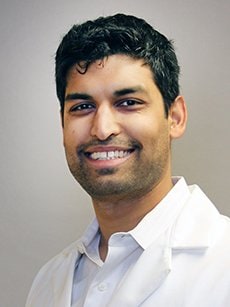Hernias: Battle of the Bulge.
By Dr. Abhishek Gupta, Bronson General Surgery, Bronson Battle Creek Hospital
As seen in Scene Magazine, December 2020

Abhishek Gupta, DO
A hernia is tear or abnormal opening that develops in the abdomen or groin area. Hernias are created when pressure combines with an area of weakness in the outer connective tissue or muscle. The build up of pressure forces tissue through this weak spot. The bulge can vary in size depending on how large an opening has developed.
Both men and women can get a hernia. Hernias can happen at any age. They can even be present at birth, usually fixed in infancy.
There are several types of hernias, which include:
- Inguinal – Located in the groin. A portion of fat, intestine or bladder pushes through the abdominal wall and into this canal. The most common type of hernia is a bulge into the scrotum, which can be large.
- Umbilical – A hernia at the belly button. Fat or intestine passes through the hernia at the belly button.
- Incisional - Develops in the abdomen when fat or intestine passes through the site of a previous surgical incision or scar.
- Ventral – Occurs anywhere in the abdomen.
- Hiatal – Occurs internally when the upper stomach pushes through the opening in the diaphragm, where the esophagus passes through.
A hernia may not present any symptoms. In other instances, individuals with a hernia may exhibit symptoms that include:
- A bulge
- Swelling
- Pain
- Discomfort in the abdomen or groin
A hernia may create more discomfort with heavy lifting, coughing, sneezing, bowel or urinary strain. Prolonged standing or sitting can also stress existing hernias. Individuals who smoke, are overweight or have an unhealthy diet can be more likely to develop a hernia. Overuse and strain on abdominal muscles can also increase the chances of a hernia. Hernias do not heal on their own, and may worsen over time. If you have a hernia, surgery may help.
Hernia repair surgery is a very common procedure. The U.S. Food and Drug Administration reports that more than one million hernia repairs occur each year in the United States. Nearly 800,000 of these are for inguinal (groin) hernias.
There are three available types of hernia surgeries available:
- Traditional open surgery. In this type of surgery, the surgeon makes an approach from the outside at the site of the hernia that is large enough to repair the hernia.
- Laparoscopic surgery. In this type of surgery, the surgeon makes several small incisions to insert instruments that allow the surgeon to repair the hernia from inside the abdomen.
- Robotic surgery. A type of laparoscopic using the most advanced tools. A few small incisions allow the surgeon to perform the surgery guiding advanced laparoscopic to perform the hernia repair. The surgeon is able to view the process in high definition on a computer monitor. As robotic surgery is the least invasive type of hernia repair, there is generally a reduction in the level of pain and a faster recovery. Recovery for this type approach is around two weeks in most cases as opposed to a typical four to six week recovery period for a traditional open surgery
Today, most hernia surgeries can be performed on an outpatient basis, allowing the patient to go home the same day
If you suspect that you may have a hernia, or have questions about hernias, please consult with your primary care provider. If hernia surgery is indicated, your doctor can provide you with a referral to our team at Bronson General Surgery Specialists in Battle Creek. In most cases, we are able to see you within a week. Urgent and emergent cases even sooner. If you have any questions please feel free to contact us at (269) 245-8310.
Abhishek Gupta, DO, is a board certified general surgeon at Bronson General Surgery Specialists in Battle Creek. As a general surgeon, he performs a number of surgeries and services including hernia repair, gallbladder surgery, lump removal and treatment for hemorrhoids. He enjoys sharing information with both his patients and the public. He always focuses on helping his patients understand their diagnosis and the treatment options available to them.